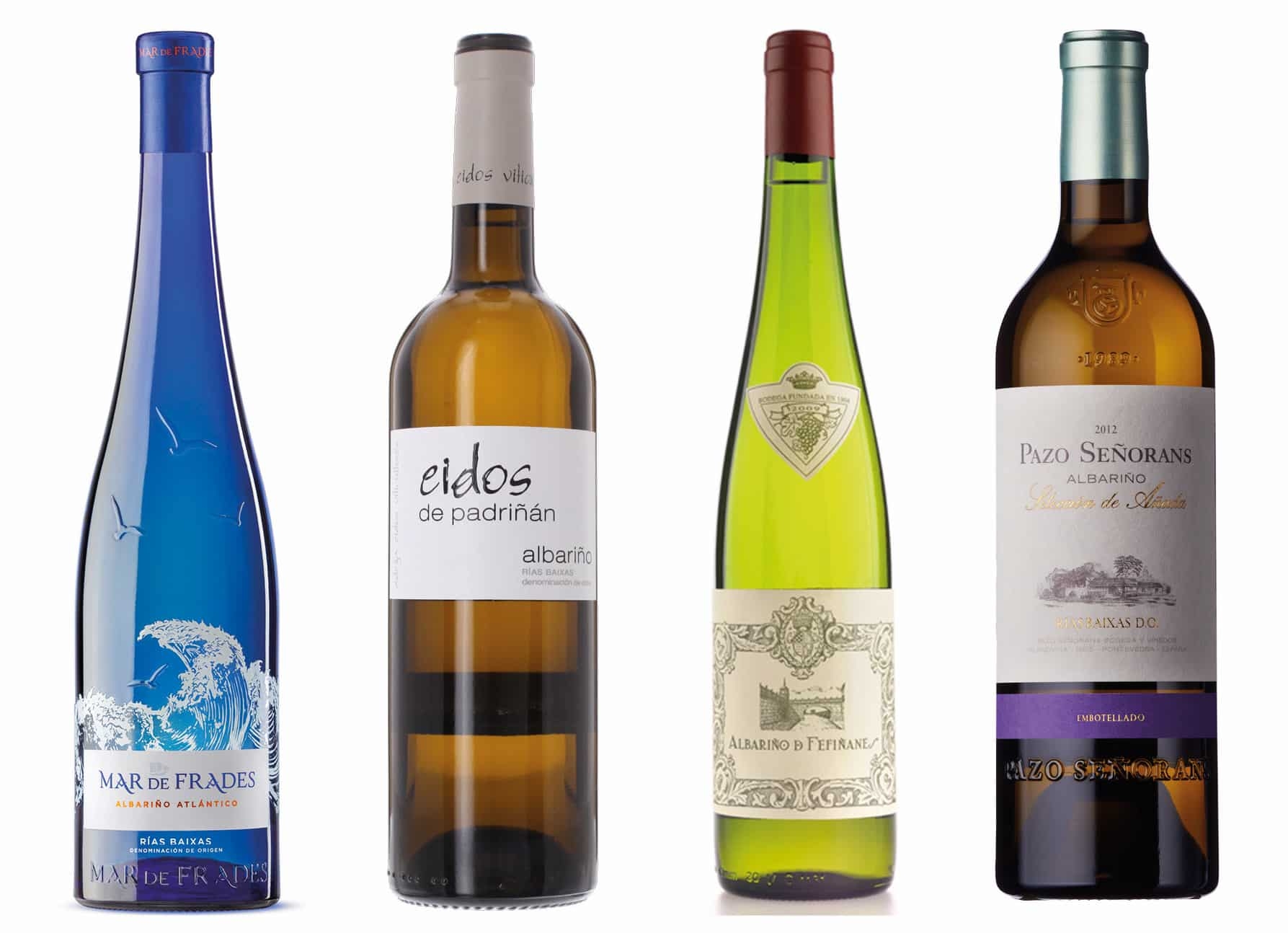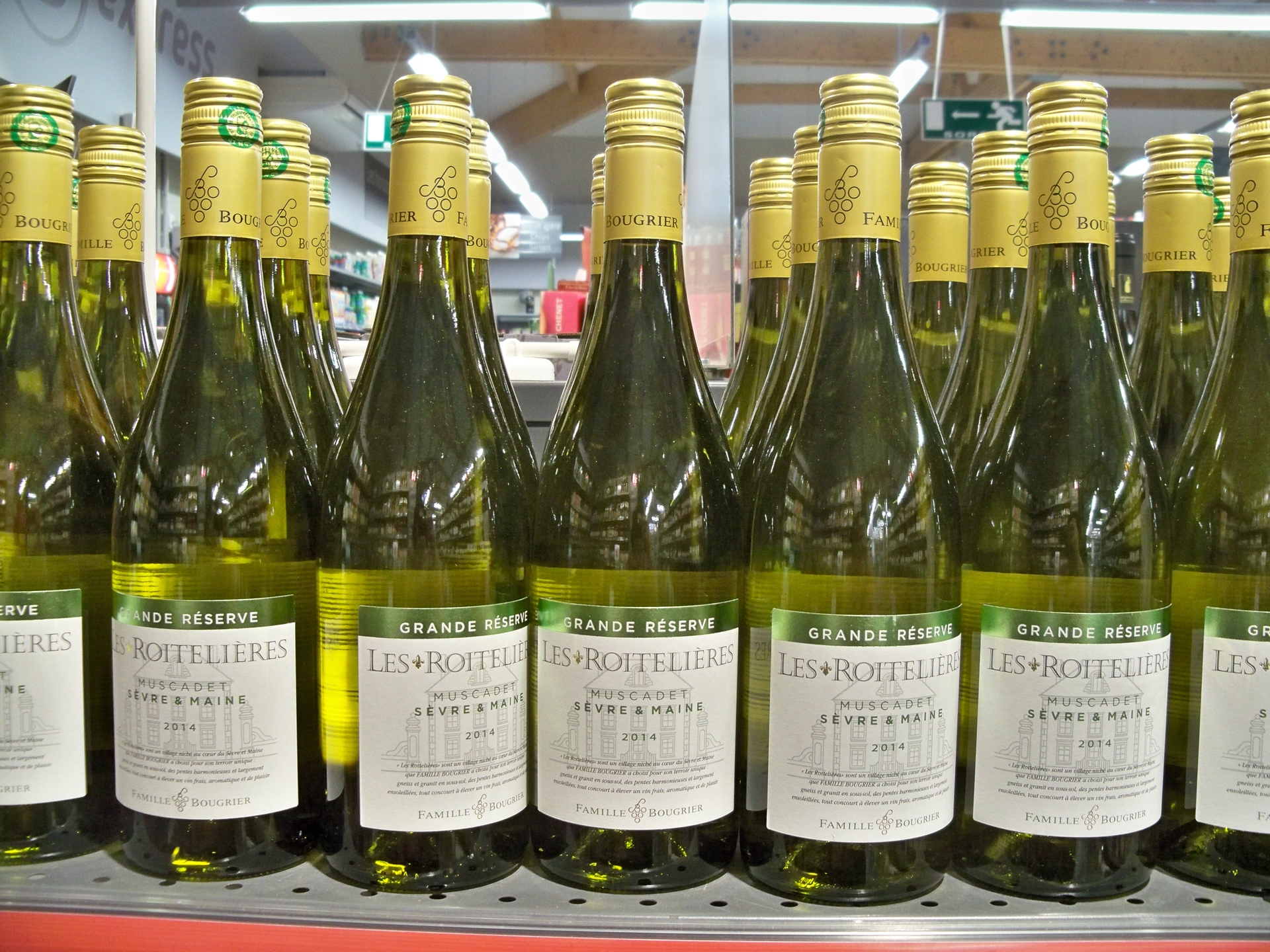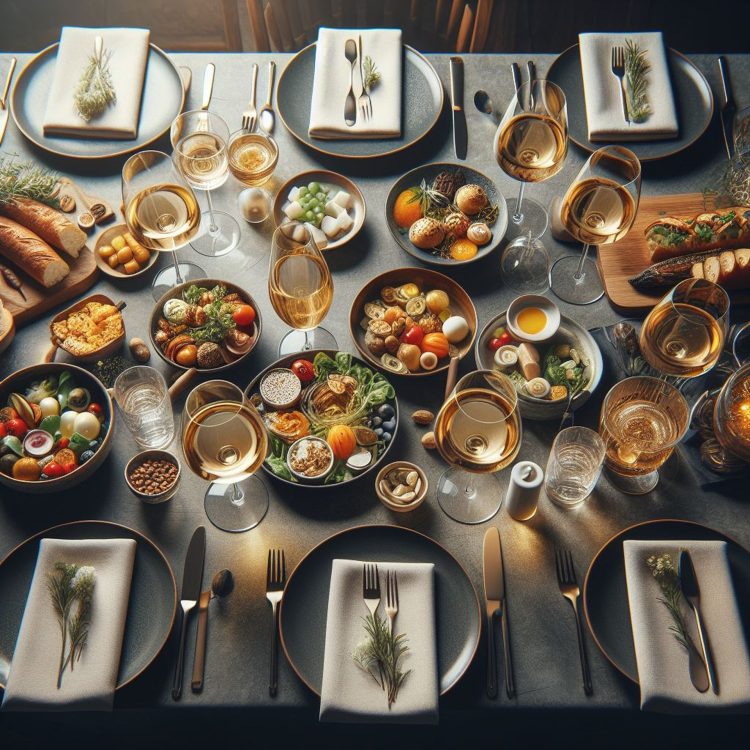Our topic in this article is “Which White Wines Are Dry?” We will dive into the world of dry white wines and examine in detail the 10 elegant dry white wines we recommend to you.
White wine enthusiasts with a discerning palate are constantly in search of elegant and refined options that offer a dry taste profile. But what exactly defines a white wine as dry? In this article, we will delve into the world of dry white wines, exploring the characteristics and varietals that are renowned for their dryness.
From the crisp and refreshing Assyrtiko to the complex and aromatic Sauvignon Blanc, we will guide you through a selection of ten elegant picks that are sure to satisfy even the most refined taste buds. So, if you’re ready to embark on a journey of discovery and indulge in the bewitching allure of dry white wines, join us as we explore the world of elegance and refinement that awaits.
Understanding Dryness in Wine
Understanding dryness in wine involves examining the concept of residual sugar, which is the natural sugar left in the wine after fermentation. However, factors other than sugar, such as fruitiness and acidity, can also affect the dryness of white wines. Exploring the reasons to choose dry white wines, including their versatility and ability to pair well with various dishes, can further enhance our understanding of their appeal.
What is Residual Sugar?
Residual sugar in wine refers to the natural sugars that remain in the wine after fermentation is complete. It is a key factor in determining the dryness or sweetness of a white wine. Dry white wines have minimal residual sugar, while sweet wines can have higher levels of residual sugar, sometimes exceeding 200 grams per liter.
The amount of residual sugar is measured in grams per liter (g/L) and can be categorized on a wine sweetness scale or white wine dryness chart. Understanding the level of residual sugar in a white wine can help guide your selection if you prefer a drier style. By referring to the white wine dryness chart or wine sweetness scale, you can easily identify the dry white wines that suit your taste preferences.
Factors Affecting Dryness Besides Sugar
After considering the residual sugar in white wines, it is important to explore the various factors that contribute to the dryness of a wine beyond just the sugar content. These factors include the characteristics of specific white wine varietals, such as Sauvignon Blanc, Chardonnay, Muscadet, and Vinho Verde, as well as the acidity level of the wine.
| White Wine Varietal | Dryness Level |
|---|---|
| Sauvignon Blanc | Very Dry |
| Chardonnay | Mostly Dry |
| Muscadet | Very Dry |
| Vinho Verde | Mostly Dry |
Sauvignon Blanc is known for its high acidity and dryness, making it an excellent choice for those seeking a crisp, refreshing white wine. Chardonnay, on the other hand, offers a range of dryness depending on the winemaker’s style preference, with some Chardonnays being oaky and buttery while others are dry and mineral-driven, like Chablis. Muscadet wines, made from the Melon de Bourgogne grape, are known for their very dry characteristics, making them a great option for those who prefer bone-dry white wine. Vinho Verde, a unique white wine from Portugal, is mostly dry and offers a light and refreshing taste profile.
In addition to the specific varietal characteristics, the acidity of a white wine can also contribute to its dryness. Wines with high acidity, such as those made from grapes like Riesling or Chenin Blanc, tend to have a drier taste profile. The acidity helps to balance out any residual sugar, resulting in a crisp and dry wine.

Why Choose Dry White Wines?
Dry white wines are popular among wine enthusiasts for their crisp and refreshing qualities, making them a perfect option for those who prefer a wine with minimal residual sugar. But why choose dry white wines? Here are a few reasons:
- Versatility: Dry white wines can be enjoyed on their own or paired with a variety of foods, making them a versatile option for different occasions.
- Elegant Picks: Dry white wines are often considered elegant and sophisticated, appealing to the discerning palate of wine connoisseurs.
- Refreshing: The absence of residual sugar in dry white wines gives them a refreshing quality that is perfect for warm weather or as a palate cleanser between courses.
- Food Compatibility: Dry white wines tend to pair well with a wide range of dishes, from light seafood to creamy pasta, enhancing the flavors and creating a harmonious dining experience.
- Contextually Relevant: Dry white wines are a popular choice in many wine-producing regions, with varietals like Chardonnay, Sauvignon Blanc, and Riesling showcasing the unique characteristics of their respective terroirs.
Which White Wines Are Dry: The World’s Driest White Wines
Which white wines are considered the driest in the world? When it comes to dry white wines, there are several elegant picks that are sure to satisfy even the most discerning palate. These wines are known for their crispness, refreshing qualities, and minimal residual sugar, making them the perfect choice for those who prefer a drier taste. Here are some of the world’s driest white wines:
| Dry White Wines | Country of Origin |
|---|---|
| Assyrtiko | Greece |
| Melon de Bourgogne | France (Loire Valley) |
| Sauvignon Blanc | France, New Zealand, Chile |
| Gruner Veltliner | Austria |
| Chenin Blanc | France (Loire Valley), South Africa |
These white wines offer a range of flavors, from the high acidity and saline qualities of Assyrtiko to the crisp and refreshing characteristics of Melon de Bourgogne and Sauvignon Blanc. Gruner Veltliner, Chenin Blanc, and other dry white wines are also worth exploring for their unique tasting notes. Whether you’re enjoying them on their own or pairing them with food, these elegant picks are sure to impress with their dryness and sophistication.
Exploring the Elegance of Dry Whites: Characteristics and Food Pairings
Now that we have explored the world’s driest white wines, it’s time to delve into the elegance of dry whites and their unique characteristics. Dry white wines are known for their crispness, high acidity, and refreshing qualities. They offer a wide range of flavors, from citrus and stone fruit to mineral and spice, making them versatile for food pairings.
Key Flavor Profiles of Dry White Wines
When exploring the elegance of dry white wines, it is important to understand the key flavor profiles that distinguish them and enhance their food pairings. Here are some key flavor profiles of dry white wines:
- Crisp and Citrusy: Dry white wines often exhibit bright acidity with flavors of lemon, lime, and grapefruit, providing a refreshing and zesty character.
- Minerality: Dry white wines can showcase mineral notes like flint, chalk, or wet stone, adding complexity and a sense of place to the wine.
- Herbal and Grassy: Some dry white wines, like Sauvignon Blanc, can have herbal and grassy aromas and flavors, reminiscent of freshly cut grass or green herbs.
- Stone Fruits: Dry white wines may also exhibit flavors of stone fruits such as peach, apricot, and nectarine, adding a touch of sweetness without actual residual sugar.
- Floral Nuances: Dry white wines can have delicate floral aromas, like jasmine or honeysuckle, which contribute to their overall elegance and aromatic appeal.
Understanding these key flavor profiles can help you choose the perfect dry white wine to complement your meal and enhance your dining experience.
Matching Dry Whites with Food: General Principles
After understanding the key flavor profiles of dry white wines, exploring the general principles of matching these elegant wines with food is essential. When it comes to pairing dry white wines with food, there are some wine pairing guidelines that can help enhance your dining experience. The table below provides a brief overview of the characteristics of dry white wines, and some suggested food pairings:
| Dry White Wine | Characteristics | Food Pairings |
|---|---|---|
| Sauvignon Blanc | Crisp, acidic, herbaceous | Goat cheese, seafood, salads, grilled vegetables |
| Chardonnay | Rich, buttery, oaky | Roast chicken, creamy pasta, lobster, buttered popcorn |
| Riesling | Aromatic, fruity, floral | Spicy Asian cuisine, smoked salmon, apple desserts |
| Pinot Grigio | Light, refreshing, citrusy | Caprese salad, grilled fish, light pasta dishes |
| Albariño | Crisp, citrusy, mineral | Grilled seafood, sushi, ceviche, oysters |
These are just general suggestions, and personal preferences may vary. The key is to find a balance between the flavors of the wine and the dish, ensuring that neither overpowers the other. Experimenting with different pairings can be a fun and rewarding experience, allowing you to discover new and exciting flavor combinations. So, the next time you enjoy a bottle of dry white wine, consider these guidelines to create a harmonious dining experience for your discerning palate.

Examples of Classic Dry Wine and Food Pairings
Classic dry white wines offer a perfect balance of crispness, acidity, and nuanced flavors, making them an ideal pairing for a variety of dishes. When it comes to food pairings, these elegant picks can elevate your dining experience to new heights. Here are some examples of classic dry wine and food pairings:
- Sauvignon Blanc with seafood: The bright acidity of Sauvignon Blanc complements the delicate flavors of seafood, such as grilled shrimp or fresh oysters.
- Chardonnay with roasted chicken: The buttery notes of Chardonnay complement the richness of roasted chicken, creating a harmonious combination.
- Riesling with spicy cuisine: The slight sweetness and acidity of Riesling balance the heat of spicy dishes, making it a perfect match for Thai or Indian cuisine.
- Pinot Grigio with light salads: The crispness of Pinot Grigio pairs well with light salads, such as a refreshing summer salad with citrus dressing.
- Chenin Blanc with creamy cheeses: The acidity of Chenin Blanc cuts through the creaminess of cheeses like Brie or Camembert, creating a delightful contrast.
These classic dry wine and food pairings showcase the versatility of white wines and the art of pairing them with different dishes. So, whether you’re a discerning palate or simply looking to enhance your dining experience, these elegant picks are sure to impress.
10 Dry White Wines for the Discerning Palate: Discovering the Dry Delights: A Bewildering Spectrum of Flavors
There is a bewildering spectrum of flavors to discover when it comes to dry white wines. From the crisp and refreshing Sauvignon Blanc to the light and zesty Pinot Grigio/Pinot Gris and the versatile and complex Chardonnay, a dry white wine suits every discerning palate. Additionally, the aromatic and refined Dry Riesling and the floral and mineral-driven Albarino offer unique tasting experiences that can elevate any dining occasion. Explore these dry delights and embark on a journey of flavor exploration.
1. Sauvignon Blanc: Crisp and Refreshing
Sauvignon Blanc is a dry white wine known for its crisp and refreshing qualities. It offers a wide range of flavors, from citrus and tropical fruit to herbal and grassy notes. Pairing well with seafood, salads, and light dishes, Sauvignon Blanc is a popular choice for those seeking a dry and vibrant white wine experience.
Flavor Profile and Examples
With its invigorating and vibrant characteristics, Sauvignon Blanc is a dry white wine that offers a refreshing experience for the discerning palate. Its flavor profile is known for being crisp and refreshing, with notes of citrus, tropical fruits, and sometimes herbaceous undertones. Some examples of elegant Sauvignon Blancs include those from Marlborough, New Zealand, which showcases bright acidity and intense fruit flavors, and those from Sancerre, France, which exhibit more mineral-driven and complex profiles.
Food Pairing Suggestions
For those seeking the perfect food pairing for a dry white wine with a discerning palate, look no further than the crisp and refreshing Sauvignon Blanc. This versatile wine pairs well with a variety of dishes, making it a popular choice for wine enthusiasts. Some excellent food pairing suggestions for Sauvignon Blanc include fresh seafood, such as oysters or grilled shrimp, as well as light salads, goat cheese, and sushi. Its bright acidity and citrus flavors complement these dishes beautifully, creating a harmonious dining experience.
2. Pinot Grigio/Pinot Gris: Light and Zesty
Pinot Grigio/Pinot Gris, being light and zesty, is the focus of this discussion on dry white wines. Known for their refreshing qualities, these wines offer a wide range of flavors, from citrus and stone fruit to mineral and spice. We will also explore suitable food pairings to enhance the enjoyment of these elegant picks.
Flavor Profile and Examples
Light and zesty, Pinot Grigio/Pinot Gris is a dry white wine that offers a bewildering spectrum of flavors for the discerning palate. Here are some examples of its flavor profile:
- Citrus: Pinot Grigio/Pinot Gris often exhibits vibrant notes of lemon, lime, and grapefruit.
- Stone Fruit: You may also taste peach, pear, and apricot hints in these wines.
- Floral: Some Pinot Grigio/Pinot Gris wines showcase delicate floral aromas, such as jasmine or honeysuckle.
- Mineral: These wines can have a stony or mineral-like quality, adding complexity to the flavor profile.
- Zesty Acidity: Pinot Grigio/Pinot Gris is known for its refreshing acidity, which gives the wine a lively and crisp character.
These elegant picks are perfect for those seeking dry white wines with a range of delightful flavors to explore.
Food Pairing Suggestions
With its vibrant flavor profile and refreshing acidity, Pinot Grigio/Pinot Gris is a versatile dry white wine that pairs beautifully with a wide range of dishes. Its light and zesty characteristics make it an elegant pick for the discerning palate. Here are some food pairing suggestions to enhance your dining experience:
| Food Pairing Suggestions | Contextually Relevant |
|---|---|
| Light seafood dishes | Fresh and delicate |
| Grilled chicken or turkey | Complements flavors |
| Citrus-based salads | Enhances brightness |
| Soft cheeses, like goat cheese | Balances creaminess |
| Light pasta dishes with white sauce | Adds depth and richness |
These suggestions will help you create a harmonious pairing with Pinot Grigio/Pinot Gris, elevating your culinary experience.
3. Chardonnay: Versatile and Complex (Unoaked/Lightly Oaked Styles)
Chardonnay is a versatile white wine known for its complexity and range of styles. From unoaked to lightly oaked, Chardonnay offers a spectrum of flavors that can satisfy the discerning palate. Its flavor profile can include notes of tropical fruit, citrus, vanilla, and butter, making it a great choice for pairing with a variety of foods.
Flavor Profile and Examples
Exhibiting a versatile and complex flavor profile, Chardonnay offers an array of dry white wines that are sure to please the discerning palate. Some elegant picks include:
- Chablis: Known for its crisp acidity and mineral-driven notes, Chablis showcases the pure expression of Chardonnay.
- Blanc de Blancs Champagne: Made exclusively from Chardonnay grapes, this sparkling wine offers delicate flavors of citrus and brioche.
- White Burgundy: From the renowned region of Burgundy, these Chardonnays display a balance of fruit, acidity, and oak.
- California Chardonnay: With a focus on ripe fruit flavors and a touch of oak, California Chardonnays offer a richer and creamier style.
- Australian Chardonnay: Often full-bodied and fruit-forward, Australian Chardonnays can exhibit tropical fruit flavors and a hint of oak.
These examples highlight the diverse flavor profiles of Chardonnay, making it a fantastic choice for those seeking dry white wines of exceptional quality.
Food Pairing Suggestions
When it comes to food pairing, dry white wines offer a wide range of options that complement and enhance a variety of dishes. For the discerning palate, some of the best dry white wines to consider include Chardonnay, Albariño, and Sauvignon Blanc. Chardonnay, in particular, is known for its versatility and complexity, with unoaked or lightly oaked styles offering a crisp and refreshing taste. Pair Chardonnay with seafood, poultry, or creamy pasta dishes for a delightful dining experience.
4. Dry Riesling: Aromatic and Refined
Dry Riesling is a highly aromatic, refined white wine appealing to the discerning palate. With its vibrant acidity and complex flavors, Dry Riesling offers a bewitching spectrum of flavors, ranging from citrus and stone fruit to floral and mineral notes. Its versatility makes it a perfect companion for a wide range of dishes, including seafood, poultry, and Asian cuisine.
Flavor Profile and Examples
Dry Riesling is a captivating choice for those seeking a dry white wine that tantalizes the discerning palate with its aromatic and refined qualities. This elegant wine offers a bewitching spectrum of flavors, including citrus, green apple, and stone fruit notes. Its vibrant acidity and mineral undertones add depth and complexity. Other examples of dry white wines include Assyrtiko from Greece, known for its high acidity, and Pinot Grigio, a versatile grape variety that can range from dry to slightly sweet depending on the region and winemaking style.
Food Pairing Suggestions
For those with a discerning palate, exploring the world of dry white wines opens up a bewitching spectrum of flavors that can be perfectly paired with a variety of dishes. With its aromatic and refined qualities, Dry Riesling is an elegant choice that pairs beautifully with seafood, poultry, and spicy Asian cuisine. Its crisp acidity and citrus notes complement these dishes, creating a harmonious and delightful dining experience.
5. Albarino: Floral and Mineral-Driven
Albarino is a white wine known for its floral and mineral-driven characteristics. With its refreshing acidity and flavors of citrus and stone fruits, Albarino is a popular choice for those seeking a dry white wine. Its versatility makes it a great pairing for seafood dishes, and it offers a delightful experience for the discerning palate.

Flavor Profile and Examples
Albarino, a dry white wine known for its floral and mineral-driven characteristics, offers a delightful spectrum of flavors for the discerning palate. Some of the flavors you can expect from Albarino include:
- Citrus: Refreshing notes of lemon, lime, and grapefruit.
- Stone Fruit: A hint of peach, apricot, or nectarine.
- Floral: Aromatic hints of white flowers like jasmine or orange blossom.
- Mineral: Subtle earthy undertones, often likened to wet stones or sea breeze.
- Herbal: Touches of herbs like thyme or fennel.
These flavors combine to create a crisp and vibrant white wine that pairs well with seafood or can be enjoyed on its own.
Food Pairing Suggestions
Albarino is an excellent choice when it comes to pairing food with dry white wines that offer a bewitching combination of floral and mineral-driven flavors. This Spanish white wine pairs well with a variety of dishes, including seafood such as grilled shrimp or fish tacos. Its refreshing acidity and citrus notes complement the flavors of lighter fare like salads or ceviche. For a more adventurous pairing, try Albarino with spicy Asian cuisine for a delightful contrast of flavors.
6. Grüner Veltliner: Peppery and Food-Friendly
Grüner Veltliner, known for its peppery and food-friendly nature, is a dry white wine that offers a unique flavor profile. This Austrian varietal often exhibits white pepper, green apple, and citrus notes, making it a refreshing choice for those seeking a vibrant and versatile wine. Grüner Veltliner pairs exceptionally well with a range of foods, including seafood, poultry, and spicy dishes, making it a fantastic option for enhancing your dining experience.
Flavor Profile and Examples
The Grüner Veltliner, with its distinct peppery notes and versatility in food pairings, is one of the dry white wines that caters to the discerning palate. Its flavor profile offers a range of delightful notes, including:
- Peppery: Grüner Veltliner is known for its unique peppery character, adding a touch of spice to its taste.
- Citrus: This white wine often exhibits citrus flavors, such as lemon and lime, adding brightness and freshness.
- Green Apple: The crispness of green apple can be found in Grüner Veltliner, providing a pleasant tartness.
- White Pepper: Alongside its peppery notes, this wine may also showcase hints of white pepper, adding complexity.
- Mineral: Grüner Veltliner often displays mineral undertones, enhancing its overall depth and sophistication.
These flavor profiles make Grüner Veltliner an excellent choice for those seeking a dry white wine with complexity and versatility in food pairings.
Food Pairing Suggestions
With its distinct peppery notes and versatility in food pairings, Grüner Veltliner is a dry white wine that caters to the discerning palate. This Austrian varietal pairs exceptionally well with a wide range of dishes. Its vibrant acidity and herbal flavors make it a perfect match for light seafood dishes, such as grilled shrimp or oysters. It also complements vegetarian dishes, salads, and spicy Asian cuisine. Grüner Veltliner’s food-friendly nature adds a delightful touch to any meal.
7. Assyrtiko: Crisp and Citrusy
Assyrtiko is a white wine known for its crisp and citrusy flavor profile. This Greek varietal offers a refreshing taste with high acidity and saline qualities. Its bright and vibrant characteristics make it a perfect choice for pairing with seafood and other light dishes.
Flavor Profile and Examples
Boasting a refreshing and vibrant character, Assyrtiko is a dry white wine that captivates the discerning palate with its crisp and citrusy flavor profile. Its flavors are reminiscent of citrus fruits like lemon and grapefruit, with hints of minerality and salinity that add depth and complexity. This elegant wine pairs well with seafood dishes, grilled vegetables, and fresh salads. Assyrtiko is a perfect choice for those seeking a dry white wine that offers a delightful balance of acidity and fruitiness.
Food Pairing Suggestions
Continuing our exploration of dry white wines, let’s now turn our attention to the art of food pairing, where the crisp and citrusy flavors of Assyrtiko shine alongside a variety of delectable dishes. Assyrtiko’s high acidity and refreshing qualities make it a versatile wine that pairs well with seafood, grilled vegetables, and dishes with tangy or creamy sauces. Here are some food pairing suggestions to enhance your dining experience with Assyrtiko:
| Dish | Assyrtiko Pairing |
|---|---|
| Grilled Shrimp | Assyrtiko’s citrus notes complement the grilled flavors of shrimp perfectly. The wine’s acidity cuts through the richness of the shrimp, creating a harmonious balance. |
| Greek Salad | Assyrtiko’s crispness and minerality make it an excellent match for the fresh and vibrant flavors of a Greek salad. The wine’s citrus undertones enhance the tanginess of the feta cheese and the acidity of the tomatoes. |
| Lemon-Garlic Chicken | The zesty flavors of lemon and garlic in the chicken dish are beautifully accentuated by the citrusy and refreshing qualities of Assyrtiko. The wine’s acidity also helps to cut through the richness of the chicken. |
| Grilled Halibut | The delicate flavors of grilled halibut are enhanced by Assyrtiko’s crisp and citrusy profile. The wine’s acidity complements the fish’s natural sweetness and adds a refreshing touch to each bite. |
| Spinach and Feta Pie | Assyrtiko’s acidity and citrus notes provide a refreshing contrast to the richness of a spinach and feta pie. The wine’s crispness helps to cleanse the palate after each savory bite. |
These food pairing suggestions showcase the versatility of Assyrtiko and how its crisp and citrusy flavors can elevate a wide range of dishes. Whether you’re enjoying grilled seafood, vibrant salads, or flavorful poultry, Assyrtiko is sure to enhance the dining experience and leave you craving for more.
8. Muscadet Sèvre et Maine: Dry and Refreshing
Muscadet Sèvre et Maine is a fresh, refreshing white wine with a unique flavor profile. With its crisp acidity and citrus and green apple notes, it pairs well with seafood dishes and is perfect for warm weather. Some notable examples of Muscadet Sèvre et Maine include Domaine de la Pépière and Château du Coing.

Flavor Profile and Examples
With its dry and refreshing nature, Muscadet Sèvre et Maine offers a bewildering spectrum of flavors that will delight the discerning palate. Some of the flavor profiles that can be found in this elegant white wine include:
- Citrus: Notes of lemon, lime, and grapefruit are zesty and vibrant.
- Green Apple: Crisp and tart, green apple flavors add a refreshing element to the wine.
- Mineral: Muscadet Sèvre et Maine often exhibits a distinct mineral quality reminiscent of wet stones.
- Saline: A subtle saline note gives the wine a briny and sea-like characteristic.
- White Flowers: Delicate floral aromas like white blossoms contribute to the wine’s elegant and aromatic profile.
These flavors combine to create a complex and nuanced experience for those seeking a dry and sophisticated white wine.
Food Pairing Suggestions
As we explore the dry and refreshing nature of Muscadet Sèvre et Maine and its bewildering spectrum of flavors, it is essential to consider the ideal food pairings that complement this elegant white wine. Muscadet’s crisp acidity and subtle minerality make it a perfect match for seafood dishes like oysters, clams, and grilled fish. It also pairs well with light salads, goat cheese, and fresh vegetables, enhancing the flavors of these dishes with its dry and refreshing characteristics.
9. Chablis: Mineral-Rich and Elegant
Chablis is renowned for its mineral-rich and elegant characteristics, making it a standout among dry white wines. Its flavor profile often includes notes of green apple, citrus, and flint, providing a refreshing and sophisticated taste. Due to its crisp acidity and clean finish, Chablis pairs exceptionally well with seafood dishes, particularly oysters.
Flavor Profile and Examples
Chablis, known for its mineral-rich and elegant characteristics, offers a bewildering spectrum of flavors that will delight the discerning palate. Here are some examples of the flavor profiles you can expect from Chablis:
- Crisp green apples
- Zesty lemon and citrus
- Steely and flinty minerality
- Subtle notes of white flowers and honeysuckle
- Refreshing acidity and a clean, dry finish
These flavors make Chablis a perfect choice for those seeking a dry, sophisticated white wine experience.
Food Pairing Suggestions
When it comes to pairing food with dry white wines, the mineral-rich and elegant flavors of Chablis make it an ideal choice for a variety of culinary experiences. Chablis pairs well with seafood dishes like oysters, scallops, and grilled fish and with lighter fare such as salads, goat cheese, and sushi. Its crisp acidity and subtle citrus and green apple notes complement these dishes, enhancing the overall dining experience.
10. Txakoli: Light and Sparkling
Txakoli, a light and sparkling white wine, is an excellent choice for those with a discerning palate. This unique wine hails from the Basque region of Spain and is known for its vibrant acidity, refreshing citrus flavors, and slight effervescence. With its distinct character, Txakoli pairs well with seafood, grilled vegetables, and light appetizers, making it a delightful option for those seeking a dry white wine with a touch of effervescence.
Flavor Profile and Examples
Dry white wines offer a bewildering spectrum of flavors, making them a delightful choice for the discerning palate. When exploring the flavor profile of dry white wines, one can expect a range of tasting notes that can be both crisp and refreshing. Here are five examples of dry white wines and their unique flavors:
- Assyrtiko from Greece: Known for its high acidity and saline qualities.
- Melon de Bourgogne (used in Muscadet wines): Offers a dry and mineral-driven taste.
- Sauvignon Blanc: Typically dry with vibrant citrus and herbaceous flavors.
- Gruner Veltliner from Austria: Known for its crisp acidity and spicy undertones.
- Chenin Blanc: Offers a range of flavors from tropical fruits to honey and nutmeg.
These dry white wines provide a diverse selection for those seeking elegant and flavorful options.
Food Pairing Suggestions
As we continue our exploration of dry white wines and their diverse flavor profiles, let’s now turn our attention to the exciting world of food pairing suggestions. When it comes to pairing dry white wines, there are numerous possibilities to enhance your dining experience. Here are some elegant picks and their recommended food pairings:
| Dry White Wine | Food Pairing Suggestions |
|---|---|
| Assyrtiko | Grilled seafood, Greek cuisine |
| Melon de Bourgogne | Oysters, shellfish, and seafood |
| Sauvignon Blanc | Goat cheese, salads, grilled vegetables |
| Gruner Veltliner | Asian cuisine, spicy dishes |
| Chenin Blanc | Poultry, pork, and creamy dishes |
These pairings are just a starting point, and the beauty of dry white wines lies in their versatility, allowing you to explore a wide range of culinary combinations. Whether you’re enjoying a crisp Assyrtiko with grilled seafood or a vibrant Sauvignon Blanc with a fresh salad, these dry white wines are sure to elevate your dining experience.
Storing and Serving Dry White Wines
When it comes to storing and serving dry white wines, there are a few key factors to consider. One important aspect is the optimal serving temperature, which can enhance the flavors and aromas of the wine. Additionally, the question of whether decanting is necessary for dry white wines may arise, as decanting can help to open up the wine and allow it to breathe.
Optimal Serving Temperatures for Dry White Wines
To ensure the best enjoyment of dry white wines, it is essential to understand the optimal serving temperatures for storing and serving these wines. Here are five key points to keep in mind:
- Serve dry white wines chilled but not too cold, as excessive coldness can mask their flavors and aromas.
- The ideal serving temperature for most dry white wines is between 45°F and 50°F (7°C and 10°C).
- Crisp and lighter-bodied dry white wines, such as Sauvignon Blanc and Pinot Grigio, are best served at the lower end of this temperature range.
- Fuller-bodied dry white wines, like Chardonnay and Viognier, can be served towards the higher end of the range to enhance their complexity.
- Remember to allow the wine to warm up slightly in the glass to fully appreciate its aromas and flavors.
Decanting: Is It Necessary for Whites?
Decanting dry white wines is a practice that is often debated among wine enthusiasts and experts. Some argue that decanting allows the wine to breathe, enhancing its aromas and flavors. Others believe that decanting is unnecessary for white wines, as they generally don’t require as much aeration as red wines.
The decision to decant a dry white wine ultimately depends on the specific wine and personal preference. If a white wine is particularly young or closed-off, decanting can help to open up its aromas and improve its overall taste. However, decanting may not be necessary if a white wine is already showing its full potential straight from the bottle.
To determine whether or not to decant a dry white wine, it is advisable to taste a small amount of the wine upon opening. If the wine is enjoyable and expressive, there may be no need for decanting. However, if the wine seems tight or closed, decanting for a short time, such as 15-30 minutes, may help reveal its full potential. Ultimately, the choice to decant a dry white wine is a matter of personal preference and experimentation.
Embracing the World of Dry White Wines: Tips and Resources
When it comes to exploring the world of dry white wines, there are a few key points to consider. First, knowing where to start your journey and familiarizing yourself with different grape varieties and regions is important. Secondly, various resources, from books and websites to wine-tasting events and classes, can help you learn more about dry white wines. By embracing these tips and utilizing these resources, you can deepen your knowledge and appreciation for dry white wines.

Where to Start Your Dry Wine Journey
Embarking on a journey to explore the world of dry white wines offers an exciting opportunity to discover diverse flavors and styles. If you’re unsure of where to start, here are some tips to guide you on your dry wine journey:
- Begin with classic dry white wine varietals like Sauvignon Blanc and Chardonnay. These widely available wines offer a good introduction to the world of dry whites.
- Explore lesser-known varietals such as Assyrtiko from Greece or Albariño from Spain. These wines offer unique flavors and characteristics that can expand your palate.
- Consider trying dry white wines from different regions. Each region has its own style and terroir, which can greatly influence the flavor profile of the wine.
- Seek recommendations from knowledgeable wine professionals or trusted sources. They can provide insights and suggestions based on your preferences and desired level of dryness.
- Attend wine tastings or join a wine club to further your exploration. These experiences provide opportunities to sample a variety of dry white wines and learn more about their nuances.
Exploring Different Grape Varieties and Regions
Continuing to explore dry white wines, it is fascinating to delve into the diverse world of grape varieties and regions that contribute to these elegant wines’ unique flavors and characteristics. The following table showcases a selection of grape varieties and their respective regions that are renowned for producing dry white wines:
| Grape Variety | Region |
|---|---|
| Assyrtiko | Greece |
| Melon de Bourgogne | Muscadet, France |
| Sauvignon Blanc | France |
| Gruner Veltliner | Austria |
| Chenin Blanc | Loire Valley, France |
Each of these grape varieties brings its own distinct qualities to the wines they produce. Assyrtiko, for example, is known for its high acidity and saline qualities, while Sauvignon Blanc is almost always dry and offers a range of flavors from citrus to grassy notes. Exploring different grape varieties and regions allows wine enthusiasts to discover new and exciting dry white wines to enjoy.
Resources for Learning More About Dry White Wines
To deepen your knowledge of dry white wines, several valuable resources are available to help you expand your understanding and appreciation of these elegant wines. Here are five resources that you can explore:
- Wine books: There are numerous books dedicated to the world of wine, including specific ones that focus on white wines. These books provide in-depth information about different grape varieties, winemaking techniques, and regions known for producing dry white wines.
- Online courses: Many reputable wine education platforms offer online courses that cover various aspects of wine, including dry white wines. These courses provide structured learning and often include videos, quizzes, and interactive materials to enhance your understanding.
- Wine tastings and events: Attending wine tastings and events allows you to try different dry white wines and learn directly from experts in the field. You can gain insights into different flavor profiles, regions, and winemaking practices.
- Wine websites and blogs: There are numerous websites and blogs dedicated to wine, where you can find articles, reviews, and recommendations specifically focused on dry white wines. These resources often provide detailed information about specific wines, regions, and food pairings.
- Wine forums and communities: Engaging with wine forums and communities online or in person allows you to connect with fellow wine enthusiasts and professionals. These platforms provide opportunities to ask questions, share experiences, and learn from others who have a passion for dry white wines.
Enhancing Your Wine Knowledge
Several resources and educational opportunities are available to deepen your understanding of white wines and enhance your wine knowledge. Further reading materials, such as books and online articles, can provide in-depth information on wine production, grape varieties, and tasting techniques. Additionally, wine education and certification programs offer structured courses and training to develop your expertise and proficiency in the world of wine. Engaging with these resources and pursuing wine education can expand your wine knowledge and appreciation, ultimately enhancing your enjoyment of dry white wines.
Further Reading and Tasting Resources
For those looking to expand their knowledge and enhance their wine tasting experience, there are a variety of resources available to explore the world of white wines further. Here are some recommended reading and tasting resources to help you on your journey:
- Wine Folly: A comprehensive website that offers articles, guides, and infographics to help you understand different white wine varietals, regions, and tasting techniques.
- Wine Spectator: A renowned magazine that provides in-depth reviews, ratings, and articles on white wines from around the world.
- The Wine Bible by Karen MacNeil: This book is a comprehensive guide to all things wine, including an extensive section on white wines, their regions, and recommended producers.
- Wine courses and certifications: Consider enrolling in wine courses or pursuing certifications like the Wine & Spirit Education Trust (WSET) to deepen your understanding of white wines.
- Wine tasting events and winery visits: Attend wine tasting events and visit wineries to experience different white wines firsthand and learn from the experts.
These resources will not only expand your knowledge but also allow you to explore and appreciate the nuances of white wines. Cheers to your wine journey!
Wine Education and Certification Programs
Expanding your knowledge and enhancing your wine-tasting experience can be achieved through wine education and certification programs, which offer comprehensive training in the world of white wines and beyond. These programs provide a structured curriculum that covers topics such as wine production, grape varieties, wine regions, tasting techniques, food and wine pairing, and more. By enrolling in these programs, you can deepen your understanding of white wines, their characteristics, and the factors that contribute to their quality.
Additionally, certification programs offer a recognized credential that can enhance your credibility and open up opportunities in the wine industry. Whether you are a wine enthusiast looking to expand your knowledge or a professional seeking to advance your career, wine education and certification programs provide a valuable platform for learning and growth in the exciting world of white wines.
Which White Wines Are Dry: Final Thoughts
In the finale, understanding the dryness of white wine is essential for those with a discerning palate. The world of dry white wines offers a wide range of elegant and refined options, each with its unique characteristics and flavors. An interesting statistic to note is that the dryness of white wine is determined by the amount of residual sugar remaining after fermentation, with some of the driest varieties having minimal sugar content. Exploring these dry white wines can truly be a delightful journey for wine enthusiasts.
If you want to expand your fine wine knowledge, I highly recommend visiting EncyclopediaWines.com. There, you can delve deeper into the nuances of white wines and beyond, enriching your understanding and appreciation of this exquisite world.







